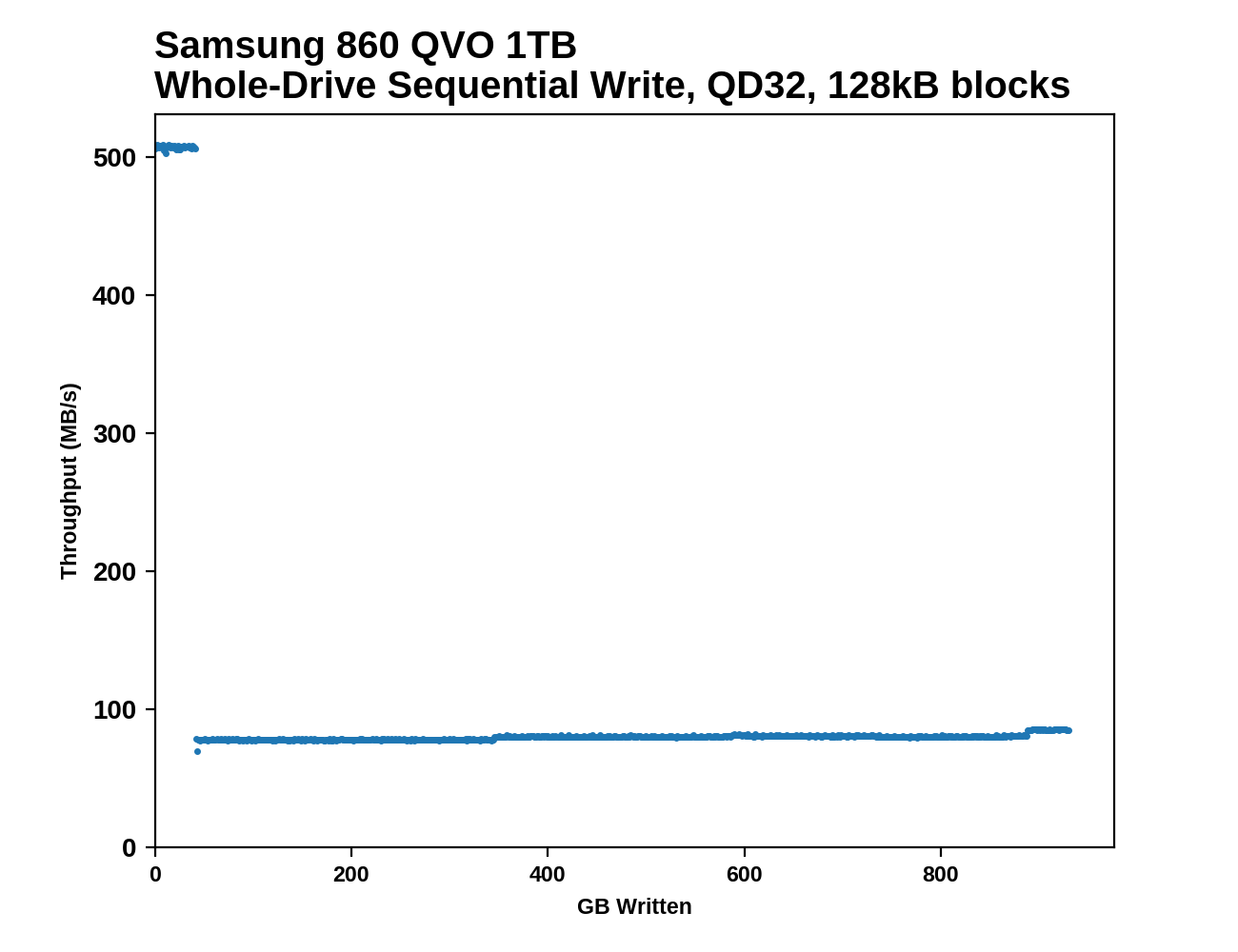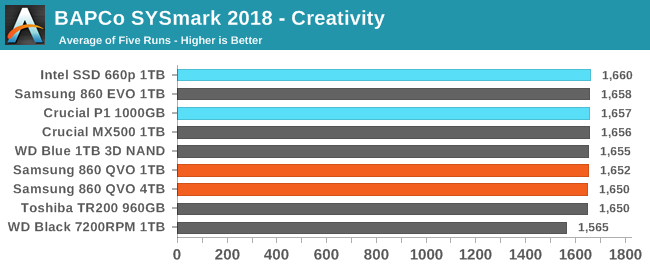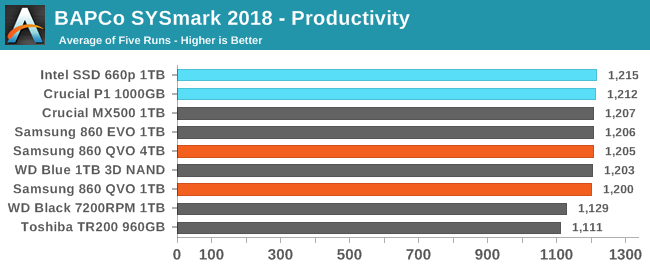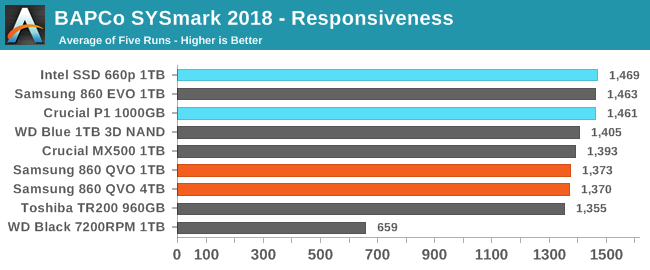The Samsung 860 QVO (1TB, 4TB) SSD Review: First Consumer SATA QLC
by Billy Tallis on November 27, 2018 11:20 AM ESTWhole-Drive Fill: Testing SLC Cache Size
This test starts with a freshly-erased drive and fills it with 128kB sequential writes at queue depth 32, recording the write speed for each 1GB segment. This test is not representative of any ordinary client/consumer usage pattern, but it does allow us to observe transitions in the drive's behavior as it fills up. This can allow us to estimate the size of any SLC write cache, and get a sense for how much performance remains on the rare occasions where real-world usage keeps writing data after filling the cache. Samsung's official specifications are:
| Samsung 860 QVO Secondary Specifications | |||||
| Capacity | 1 TB | 2 TB | 4 TB | ||
| SLC Cache Size |
Min | 6 GB | 6 GB | 6 GB | |
| Max | 42 GB | 78 GB | 78 GB | ||
| Sequential Write |
SLC Cache | 520 MB/s | |||
| QLC | 80 MB/s | 160 MB/s | 160 MB/s | ||
Our results show the following:
 |
|||||||||
The Samsung 860 QVOs run out of SLC cache right on schedule, at 42 GB for the 1TB model and 78 GB for the 4TB. After that, they are both slow and very steady for the rest of the test.
 |
|||||||||
| Average Throughput for last 16 GB | Overall Average Throughput | ||||||||
The 1TB 860 QVO falls below the sequential write speed of a 1TB hard drive once the SLC cache runs out, but the 4TB model is able to sustain twice the write speed and remains ahead of not just the hard drive's speed, but also some of the slower TLC drives.
BAPCo SYSmark 2018
BAPCo's SYSmark 2018 is an application-based benchmark that uses real-world applications to replay usage patterns of business users, with subscores for productivity, creativity and responsiveness. Scores represnt overall system performance and are calibrated against a reference system that is defined to score 1000 in each of the scenarios. A score of, say, 2000, would imply that the system under test is twice as fast as the reference system.
SYSmark scores are based on total application response time as seen by the user, including not only storage latency but time spent by the processor. This means there's a limit to how much a storage improvement could possibly increase scores, because the SSD is only in use for a small fraction of the total test duration. This is a significant difference from our ATSB tests where only the storage portion of the workload is replicated and disk idle times are cut short to a maximum of 25ms.
| AnandTech SYSmark SSD Testbed | |
| CPU | Intel Core i5-7400 |
| Motherboard | ASUS PRIME Z270-A |
| Chipset | Intel Z270 |
| Memory | 2x 8GB Corsair Vengeance DDR4-2400 CL17 |
| Case | In Win C583 |
| Power Supply | Cooler Master G550M |
| OS | Windows 10 64-bit, version 1803 |
Our SSD testing with SYSmark uses a different test system than the rest of our SSD tests. This machine is set up to measure total system power consumption rather than just the drive's power.



The 860 QVO isn't any slower for compute-heavy interactive tasks than the mainstream SATA SSDs, and even on the more I/O-bound Responsiveness test the 860 QVO is ahead of the DRAMless TLC drive and not far behind the Crucial MX500.
Energy Use
The SYSmark energy usage scores measure total system power consumption, excluding the display. Our SYSmark test system idles at around 26 W and peaks at over 60 W measured at the wall during the benchmark run. SATA SSDs seldom exceed 5 W and idle at a fraction of a watt, and the SSDs spend most of the test idle. This means the energy usage scores will inevitably be very close. A typical notebook system will tend to be better optimized for power efficiency than this desktop system, so the SSD would account for a much larger portion of the total and the score difference between SSDs would be more noticeable.

The Samsung 860 QVO's energy usage during SYSmark is not a problem at all, with it using slightly less energy than the mainstream SATA TLC drives.










109 Comments
View All Comments
CheapSushi - Wednesday, November 28, 2018 - link
Yeah the premise was cheaper NAND for bulk storage with compromises. That way all okay in my mind. But as shown, there's just no good value proposition here yet. Just inherently I figured QLC would be 33% cheaper than TLC and then mass production and the higher density stacking would bring that down further. But...I guess not.nagi603 - Friday, November 30, 2018 - link
At $400 I'd toss out all the current HDDs of my NAS. Maybe in a few years.... or not, as the HDD prices/capacities move too.azazel1024 - Friday, November 30, 2018 - link
My price point is roughly 8 cents a GB and performance of at least 250MB/sec sustained writes/reads.Which these aren't at. That might mean a few more generations of TLC drives to get there. I don't know. My use case is replacing the spinning rust in my desktop and server. I mirror storage between them and I am running dual 1GbE interfaces with SMB Multichannel. So I can push about 235MB/sec across.
Sometimes I am just shoving a few GB file (sometimes one or two single digit MB sized files, but more often larger ones). On rare occasions I am backing up completely from one machine to the other, because reasons. So when tossing 2-3TB of data, I don't need my transfer "stalling" at 80MB/sec, or even 160MB/sec. Hopefully soon networking prices on 2.5/5/10GbE will drop enough I will upgrade there. I don't necessarily need to saturate a 2.5GbE, let alone 5 or 10GbE interface with big transfers.
So my benchmark is 250MB/sec sustained on full disk transfers. That way I don't need to set up drives in RAID to accommodate higher speeds. As one of things I am looking forward to/hoping for with SSDs is being able to move to storage pools/JBOD type setup so that as I start pushing my capacity limits, I can just add a new drive, rather than needing to replace an entire array. And those sustained speeds better be able to manage that with the disk 80-90% full. One of those things that makes me shy away from using HDD arrays that full is the performance suffers a lot once you start getting that far in on the tracks (my current 2x3TB RAID0 arrays can push about 320MB/sec when on the outer tracks, on the inner ones it is only about 190MB/sec).
Once of these days I could justify dishing out $600-800 to replace my 2x3TB arrays with 5-6TB of storage in each machine. Especially if it is storage that I can potentially keep using for a long time (I don't know, call it a decade or so) by just adding a new disk once capacity starts getting low, rather than replacing all of them. But I need/want good performance while I am at it.
For my server I can still comfortably live with a 60GB system drive. When I upgrade it, I will likely FINALLY replace the old SATAII SSD in there with a newer SATAIII 120GB SSD or get an M.2 120GB depending on what the board will support. Basically the smallest capacity I can get. It doesn't need heaps of performance. My desktop I will likely get a 500GB M.2 TLC drive once I finally upgrade it (currently running a last generation 256GB TLC SATAIII drive as the system disk).There I'd like some nice performance, but frankly a good M.2 TLC drive with 512GB is big enough jump in performance I don't care to spend the money on an MLC drive for the system disk.
TheCurve - Tuesday, November 27, 2018 - link
Another great review from Billy. Love reading your stuff!rocky12345 - Tuesday, November 27, 2018 - link
This is great and a step closer to getting rid of spinning drives but they are not there yet. The prices of these Samsung drives are far better at the 4TB range but I just picked up a 4TB WD Blue for $99 Canadian on the black Friday sales granted that same drive before the sale was $209.99 Canadian but even still far cheaper than the $599.99US for the Samsung 4TB almost SSD drive.With all of that said I am very happy to see large TB drives for SSD coming into a lower price range probably going to be another 5-6 years before the prices match for spinning and SSD drives or if Seagate and WD totally stop making spinning drives then of coarse we have nothing to fall back on if we want large TB hard drives in our systems for data storage and we will have to pay the price of these types of SSD drives.
On a side note my fear is that when Seagate and WD stop making spinning drives SSD drive prices might sky rocket because we have no other option. The only reason SSD drives are coming down in the larger sizes is these companies are trying to compete with large TB spinning drives on price points.
kpb321 - Tuesday, November 27, 2018 - link
I'm not sure SSD's will ever pass up HD's for $ per GB for pure bulk storage. Even the "Cheap" 4tb SSD is around the cost of 2x 10 TB HDs so somewhere around 5X more expensive in $ per GB. Not an impossible margin but still a lot of ground to make up vs a moving target. What has happened is SSDs have gotten "big enough" and "cheap enough" that for many people they are viable as the only drive in their machine. Looking at Newegg it's ~$45 for your basic 1tb hd and you can pick up a cheap ~250gb SSD for a little less or a ~512gb SSD for a little more. I'd certainly prefer a 250 or 512 gb SSD as the drive in my system over a 1tb HD but if you do need bulk storage (1tb+) HDs are still hard to beat. 3TB hd's start off at ~$85 and continue to be more cost effect at higher sizes so I don't think HDs will completely vanish. They may become increasingly specialized to bulk storage and cloud providers with things like SMR trading off some performance for increased density but I doubt they will go away. Cheap PC mfgs do still seem to like the cheap 1tb hds. About the same cost as a small but usable SSD but give big numbers for the ads.dontlistentome - Tuesday, November 27, 2018 - link
It's about 10 years ago that I bought an Intel 80GB drive for $250. We're getting 2TB flash for that now - about a factor of 25 times reduction in price.Another 5 times cheaper? Easy.
DanNeely - Tuesday, November 27, 2018 - link
For comparison, in 2008 the biggest HDDs were apparently 1.5TB in size; that drive launched at ~$215 (although it rapidly dropped afterward). For comparison a 14TB Ironwolf is $530 at B&H. That's 9.3x more capacity at at 2.4x the price; or roughly at 3.8x improvement in price per TB at the top end. Or only 2.7x is you use the ~$150 price estimated price for nov 08.Flash might end up needing to drop 10x in price per TB to beat spinning rust; but it has momentum behind it, and the more market share it wins based on size/power/performance the more economies of scale and larger R&D budgets will tilt the floor in its favor.
https://www.tomshardware.com/reviews/hdd-terabyte-...
https://camelcamelcamel.com/Seagate-Barracuda-7200...
Lolimaster - Thursday, November 29, 2018 - link
Ever heard of law of diminishing returns?At 1st tech is hard to produce and sell than it scales till you reach a wall, same with flash cards at the times of N64, 32-64MB for $100.
Even HDD's which a well known tech is having a hard time executing the next step, HAMR which should boost capacities to 20-50TB, 4 years of delay.
The_Assimilator - Thursday, November 29, 2018 - link
Just like HDDs never passed tapes in cost/GB for bulk storage.